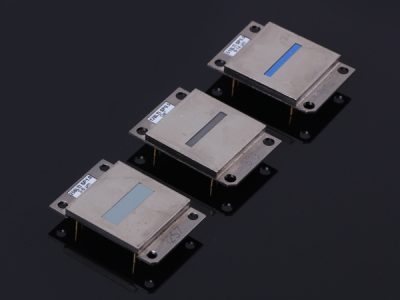Sensors with extremely high detectivity for greater safety, health and environmental protection
15. Jan 2017
The highly sensitive PYROSENS pyroelectric infrared sensors and linear arrays designed by DIAS Infrared GmbH are based on proven pyroelectric lithium tantalate technology. The sensors are used mainly in gas analysis and spectroscopy applications, but also in non-contact temperature measurement and safety engineering.
For more than two decades, DIAS has been active in the research and development of these high-quality sensors achieving an extremely high detectivity of 109 cm Hz1 / 2 W-1. The use of very thin LiTaO3 sensor chips enables this high detection sensitivity. With modern ion beam etching technology, the DIAS PYROSENS series sensors offer an above-average signal-to-noise ratio. This means that the user has an easier task extracting low level signals of interest from the baseline noise.
The sensitivity and the high quality of the DIAS sensors are essential for demanding applications in gas analysis and spectrometry. For example, in case of studies in the food industry, it is not only possible to determine whether a certain substance is present in a food sample, but also in what concentration it is present. This allows researchers and quality inspectors to quantify, among other things, how much “organic” is in the food, or to probe nutrient concentration.
For special applications in temperature measurement, laser characterization, flame detection, medical, safety and environmental measurement technology, the sensors long-term stability and detectivity (D*) are important criteria. The “sensitive sensors” are also used in the agricultural industry. For example, in determining the quantity and type of fertilizer must be applied to the fields to optimize the soil conditions. Thus, the plants get enough nutrients, while limiting excess fertilizer that would otherwise negatively impact waterways and the surrounding environment. The sensors are widely used in process automation and monitoring as well as quality assurance in all branches of industry.
DIAS manufactures a wide range of pyroelectric single element sensors, pyroelectric multi-element sensors and pyroelectric linear arrays.
The PYROSENS series of linear array detectors with 128, 256 or 510 elements, spanning 12.8 mm, contain, an integrated CMOS readout circuit for low-noise amplification and serialization of the detected signal at each linear element. These linear arrays are particularly suitable for use in compact infrared spectrometer solutions. Very long elements (typically 0.5 mm or 1 mm) are available for high signal-to-noise ratios. Compared to the standard arrays, variants with a sensitivity of up to a factor of 16 are available. New now are variants with a high spectral resolution, even at low radiation modulation frequencies. This is achieved by a very good thermal insulation between the individual sensor pixels with micro-mechanically produced 3D structures.
An evaluation kit is available for all linear PYROSENS arrays. The USB interfaced evaluation kit allows users to easily operate the arrays and import data to a Windows computer. The kit includes provisions for synchronization with other system components, e.g. for radiation modulation and the selection of the read-out rate in the range between 1 and 80 lines / s. Software included with the kit allows for signal visualization and data storage for later analysis.
The sensors are manufactured to the highest quality standards at DIAS Infrared GmbH in Dresden, Germany. With this exceptionally flexible technology, both low quantity production as well as special modifications to standard products, are easily realized. With more than 60 single and multi-channel sensor types and more than 10 different linear arrays in production, DIAS consistently offers comparatively short delivery times.
The 128 LTI and 256 LTI pyroelectric arrays have now been improved in their signal-to-noise ratio. The new sensors will be shown at SPIE Photonics West, San Francisco, booth 4453.